Dysrhythmia stuvia 2024 - Study guides, Class notes & Summaries
Looking for the best study guides, study notes and summaries about Dysrhythmia stuvia 2024? On this page you'll find 20 study documents about Dysrhythmia stuvia 2024.
Page 2 out of 20 results
Sort by
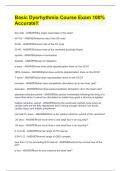
-
Basic Dysrhythmia Course Exam 100% Accurate!!
- Exam (elaborations) • 6 pages • 2024
-
- $11.59
- + learn more
SA node - ANSWERthe major pacemaker of the heart 60-100 - ANSWERinherent rate of the SA node 40-60 - ANSWERinherent rate of the AV node 20-40 - ANSWERinherent rate of the ventricles (purkinjie fibers) systole - ANSWERphase of contraction diastole - ANSWERphase of relaxation p wave - ANSWERwhat does atrial depolarization show on the ECG? QRS complex - ANSWERwhat does ventricle depolarization show on the ECG? T wave - ANSWERwhat does repolarization show on the ECG? incre...
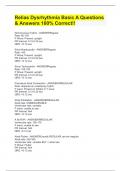
-
Relias Dysrhythmia Basic A Questions & Answers 100% Correct!!
- Exam (elaborations) • 5 pages • 2024
-
- $10.99
- + learn more
Normal sinus rhythm - ANSWERRegular Rate: 60-100 P Wave: Present, upright PR Interval: 0.12-0.20 sec QRS: <0.12 sec Sinus Bradycardia - ANSWERRegular Rate: <60 P Wave: Present, upright PR Interval: 0.12-0.20 sec QRS: <0.12 sec Sinus Tachycardia - ANSWERRegular Rate: 100-150 P Wave: Present, upright PR Interval: 0.12-0.20 sec QRS: <0.12 sec Premature Atrial Contraction - ANSWERIRREGULAR Rate: depends on underlying rhythm P wave: Present or hidden in T wave PR...
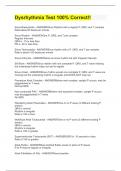
-
Dysrhythmia Test 100% Correct!!
- Exam (elaborations) • 3 pages • 2024
-
- $10.99
- + learn more
Sinus Bradycarida - ANSWERSInus Rhythm with a regular P, QRS, and T complex Rate below 60 beats per minute Sinus Rhythm - ANSWEROne P, QRS, and T per complex Regular Intervals QRS is .10 or less than PR is .20 or less than Sinus Tachycardia - ANSWERSinus rhythm with a P, QRS, and T per complex Rate is above 100 beats per minute Sinus Arrhymia - ANSWERSame as sinus rhythm but with irregular intervals SA Block - ANSWERSinus rhythm with one complete P, QRS, and T wave missing ...
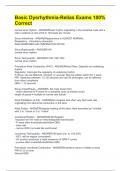
-
Basic Dysrhythmia-Relias Exams 100% Correct
- Exam (elaborations) • 3 pages • 2024
-
- $10.99
- + learn more
normal sinus rhythm - ANSWERheart rhythm originating in the sinoatrial node with a rate in patients at rest of 60 to 100 beats per minute Sinus Arrhythmia - ANSWERAppearance is ALMOST NORMAL: Respiratory - Circulatory interaction Rate INCREASES with INSPIRATION (IN=IN) Sinus Bradycardia - ANSWER<60 normal sinus rhythm Sinus Tachycardia - ANSWER>100 (100-150) normal sinus rhythm Premature Atrial Contraction (PAC) - ANSWERHeart Rate: Depends on underlying rhythm Regularity: ...
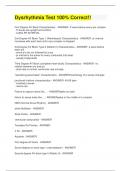
-
Dysrhythmia Test 100% Correct!!
- Exam (elaborations) • 2 pages • 2024
-
- $10.99
- + learn more
First Degree AV Block Characteristics - ANSWER- P wave before every qrs complex - P waves are upright and uniform - LONG PR INTERVAL 2nd Degree AV Block Type 1 (Wenkebach) Characteristics - ANSWER- pr interval increases with each beat until a qrs complex is dropped 2nd Degree AV Block Type 2 (Mobitz II) Characteristics - ANSWER- p wave before each qrs - some p's are not followed by a qrs - pr interval is the same for every conducted (full) beat - usually bradycardic Third Degree A...
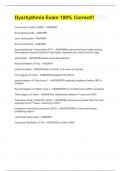
-
Dysrhythmia Exam 100% Correct!!
- Exam (elaborations) • 1 pages • 2024
-
- $10.49
- + learn more
normal sinus rhythm (NSR) - ANSWER Sinus Bradycardia - ANSWER sinus tachycardia - ANSWER Sinus Arrhythmia - ANSWER Supraventricular Tachycardia (SVT) - ANSWERan abnormal heart rhythm arising from aberrant electrical activity in the heart; originates at or above the AV node atrial flutter - ANSWERbaseline looks like sawtooth Atrial Fibrillation (A-Fib) - ANSWER
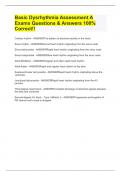
-
Basic Dysrhythmia Assessment A Exams Questions & Answers 100% Correct!!
- Exam (elaborations) • 1 pages • 2024
-
- $10.49
- + learn more
Cardiac rhythm - ANSWERThe pattern of electrical activity in the heart Sinus rhythm - ANSWERNormal heart rhythm originating from the sinus node Sinus tachycardia - ANSWERRapid heart rhythm originating from the sinus node Sinus bradycardia - ANSWERSlow heart rhythm originating from the sinus node Atrial fibrillation - ANSWERIrregular and often rapid heart rhythm Atrial flutter - ANSWERRapid and regular
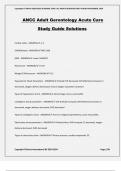
-
ANCC Adult Gerontology Acute Care Study Guide Solutions
- Exam (elaborations) • 39 pages • 2024
- Available in package deal
-
- $12.49
- + learn more
ANCC Adult Gerontology Acute Care Study Guide Solutions Cardiac Index - ANSWER-2-4 SVR/Afterload - ANSWER-800-1200 MAP - ANSWER-mean CVx80/CO PA pressure - ANSWER-15-30 Wedge PCWP pressure - ANSWER-6-12 Hypovolemic Shock Parameters - ANSWER-Preload CVP decreased, SVR afterload increased, CI decreased, Oxygen delivery Decreased, Venous Oxygen saturation increased Types of hypovolemic shock - ANSWER-Hemorrhage, burns, pancreatitis Cardiogenic shock parameters - ANSWER-CVP preload increas...
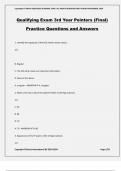
-
Qualifying Exam 3rd Year Pointers (Final) Practice Questions and Answers
- Exam (elaborations) • 59 pages • 2024
-
- $12.49
- + learn more
Qualifying Exam 3rd Year Pointers (Final) Practice Questions and Answers 1. Identify the regularity of the ECG rhythm shown above. 1/1 B. Regular C. The ECG strip misses out important information. D. None of the above A. Irregular - ANSWER-A. Irregular 2. What is the heart rate of the patient? (refer to the figure above) 1/1 C. 90 B. 80 D. 10 A. 70 - ANSWER-B. 80 3. Appearance of the P waves. (refer to figure above) 1/1 Copyright © KAYLIN 2024/2025 ACADEMIC YEAR. ALL RIGHTS RESE...
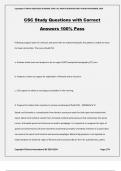
-
CSC Study Questions with Correct Answers 100% Pass
- Exam (elaborations) • 74 pages • 2024
-
- $13.49
- + learn more
CSC Study Questions with Correct Answers 100% Pass Following surgical repair of a thoracic aneurysm with an endoluminal graft, the patient is unable to move his lower extremities. The nurse should first a. Activate stroke team and prepare to do an urgent (STAT) computed tomography (CT) scan b. Prepare to return to surgery for exploration of femoral artery occlusion c. Call surgeon to obtain a neurology consultation in the morning d. Prepare for lumbar drain insertion to remove cerebrospin...

Do you wonder why so many students wear nice clothes, have money to spare and enjoy tons of free time? Well, they sell on Stuvia! Imagine your study notes being downloaded a dozen times for $15 each. Every. Single. Day. Discover all about earning on Stuvia


